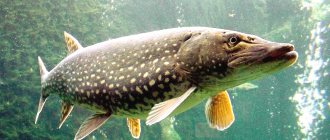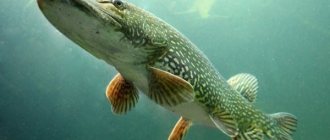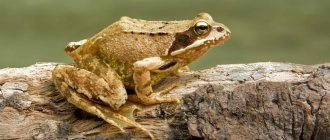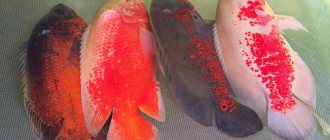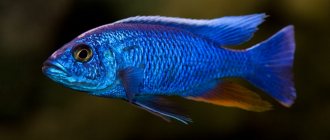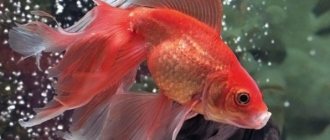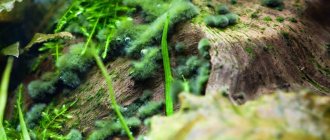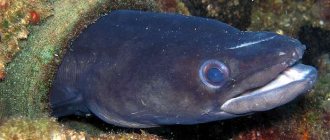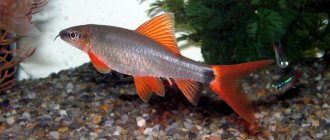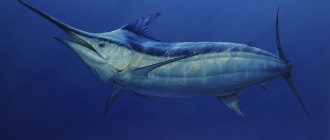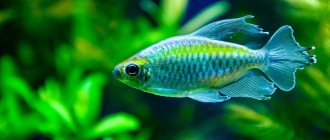Habitat and appearance features
The armored pike belongs to the armored pike family. Its homeland is North America, however, this subspecies is occasionally found in the waters of South America. It is believed that the armored pike is one of the oldest animals that has gone through a huge evolutionary path. According to scientists, the first representatives of this species of predatory fish appeared about 7 million years ago.
Pike is characterized by its large size and very hard, dense scales, resembling diamonds in shape. The average size of an adult is about 1-1.5 m, so this fish is only suitable for very large aquariums or artificial reservoirs and ponds.
It has a torpedo-shaped body , an elongated muzzle with sharp, strong teeth . The armored pike looks extremely impressive due to its unusual color. The body of the fish has a light olive tint, and along it there are rich dark spots that form original, bizarre patterns.
It is noteworthy that, despite the fact that in its natural habitat the armored pike can reach 2 m, in aquarium conditions it stops growing. Moreover, the smaller the volume of the artificial reservoir, the faster the growth processes are inhibited. Aquarium armored pikes with a length of only 40-45 cm are quite common.
With its special structure, this fish differs from other subspecies. For example, segments of her spinal column only have one-sided depressions, not two-sided ones. Pike has a swim bladder, which helps normalize and maintain respiratory function. The jaw apparatus in appearance resembles a bird's beak; this structure allows the armored pike to capture and hold its prey before swallowing it.
The visual apparatus of this fish is also interesting. The pike has unique bipolar vision and all-round visibility, which is achieved thanks to its huge and very protruding eyes. The fins are very similar in appearance to sharks and are covered with sharp scales. Swimming in the aquatic environment, this large fish resembles a log, which is very convenient in terms of camouflage when hunting in natural conditions.
Spreading
The adjective “Mississippi” in the name of the fish indicates its main habitat. The natural distribution range is the lower Mississippi River, Gulf Coast of the southern United States and Mexico (Fig. 3).
Rice. 4. Distribution of the alligator gar in Central and North America. Source: discoverlife.org
Mississippi alligator fish prefer water bodies without currents or calm rivers. You can often find them in large rivers, as well as in brackish creeks. Shellfish, native to the Mississippi Basin, are more comfortable in salt water than other native fish species.
Several finds of the alligator gar have been recorded outside of America. Individuals ranging from one and a half to two meters in length were found in Turkmenistan, Hong Kong, Singapore, and India. It is believed that this is the result of the activities of aquarium enthusiasts and owners of private ponds.
Necessary conditions for keeping in an aquarium
The armored pike is a rather unusual fish, so it is not particularly suitable for beginners. It is best for experienced aquarists who understand how to properly handle predators to have such a bizarre pet. First of all, for the armored pike, due to its large size, you will need a large, voluminous aquarium, designed for 150 liters or more.
Since the animal is prone to solitude, the pond will need to be decorated in advance with dense thickets of algae and greenery. It is important to provide sufficiently bright, intense lighting and weak water flow. The optimal temperature regime can vary from +18 to +25°C. Recommended water hardness values are 8-17, and acidity values are pH 6.5-8.
Sufficient filtration and aeration are of great importance, which should also be taken care of before adding pike to the aquarium by purchasing powerful, high-quality devices. Due to the activity and strength of the armored pike, all decorative elements present in the aquarium must be very carefully secured, preferably fixed to the bottom.
It should be noted that armored pikes are quite active and mobile, especially at night, and often make attempts to jump out of the water.
For this reason, in order to avoid possible troubles and even death of the fish, it is necessary to cover the aquarium with transparent glass.
Commercial significance
The wild population of the carapace does not have serious commercial significance due to its small numbers. It is caught for the sake of extreme sports, sporting interest. Fishermen love to take pictures with their trophies, making sure to indicate their size. The decline in the population of the alligator gar has led to the need to regulate the catch. Alligator gar has a high yield of meat - white fillet and a small percentage of waste in relation to body weight. Gar caviar is poisonous, but the meat is sold to wholesalers as well as retail in supermarkets with prices starting at around US$7 per kilogram. There is also a small handicraft production of products made from fish skins such as bags, wallets, etc.
Shellfish are considered promising aquaculture targets, especially in developing regions. This is facilitated by rapid growth, disease resistance, easy adaptation of juveniles to artificial feed, and undemandingness to high water quality. And the ability to breathe atmospheric air eliminates expensive aeration systems and simplifies cultivation technologies typically used in aquaculture. Broodstocks have been established in the southern United States, Mexico and Cuba, and farmed fish have already become a popular food product there.
Nutritional Features
The armored pike is a predator by nature, which determines its diet. Ideal food would be worms, small fish, tadpoles, crustaceans or worms. However, frozen shrimp, squid and other seafood are also perfect. It is also possible to purchase ready-made specialized food, developed specifically taking into account all the characteristics and needs of the body of large predatory fish.
Some novice aquarists feed the armored pike with pieces of natural meat, but, according to experts, this is extremely undesirable. The fact is that the lipids contained in meat are poorly absorbed and tolerated by the body of the inhabitants of the aquatic world, which can provoke the development of obesity, indigestion and other diseases of the digestive system.
Feeding armored pike is a rather complex and unusual process.
You should only offer food to the fish using tweezers, since it will not feed from the bottom, and hand movements can provoke innate hunting instincts and lead to serious injuries to the aquarist.
Adults are fed 1-2 times a week. But young pikes should be fed more often in order to speed up their growth processes and ensure the full development of all internal organs and systems. Since pike are predominantly nocturnal, evening hours are considered the optimal time for feeding.
General information
Armored pike (Lepisosteus sp.) This is a genus of freshwater and brackish-water fish with meadow fins from the armored family. Found in rivers of North America. Currently, the genus includes only 4 species. They are generally frequent visitors to public aquariums and aquariums as they can reach sizes of up to 2.5 m. However, juveniles are easily kept in larger home aquariums.
Ganoid scales of pike shell
The armored pike is a very ancient fish. One of the signs indicating their distant origin is the presence of ganoid scales. It consists of incredibly dense three-layer “tiles” covering the entire body of the fish. The outer layer is very similar in strength to tooth enamel. This shell perfectly protects the fish from natural enemies, which, it should be noted, are practically absent. Most often, armored pike are found at the top of the food chain.
The vertebrae of fish also have an unusual structure: only on one side they have a depression, and on the other they are convex.
In addition to gill breathing, the armored pike can breathe with its swim bladder, which is woven into a network of blood vessels. This allows the fish to survive in rather difficult conditions, for example, during periods of drought, when the oxygen content in the water drops sharply.
According to their lifestyle, armored pikes are ambush predators; they hunt mainly at night, hiding among thickets of aquatic plants.
Armored pikes - ambush predators
Despite their rather large size, pike have no commercial value. The yield of meat from the fish is small, and its taste leaves much to be desired. However, such a trophy is a long-awaited catch for sport fishing enthusiasts.
The most dangerous enemy for armored pikes is people. First of all, the pollution of water bodies with industrial waste affected fish populations.
Behavior and compatibility with other aquarium inhabitants
Armored pikes tolerate loneliness well, so it is best to keep them alone in the aquarium, especially since due to their large size it is quite difficult to find an artificial reservoir of suitable volume.
When deciding to keep an animal in the same aquarium with other aquatic inhabitants, it is important to take into account their natural hunting instincts and avoid proximity to small fish. The optimal neighbors for the armored pike will be large representatives of the aquatic world:
- arowanas;
- American cichlids;
- knife fish;
- sturgeon;
- polypterus;
- piranha pacu;
- sacbranch or chain catfish;
- tilapia.
The most important thing is that the fish are large enough to avoid their possible absorption by the armored pike. It is strictly not recommended to stock predatory fish in the same tank with shrimp, clams, mussels, and small peaceful fish, as they will be destroyed by the predator literally within 24 hours.
In terms of behavior, armored pikes are rather phlegmatic and calm. They are active when hungry, during hunting, or when potential prey comes into view. At times they like to swim in the upper layers of water. They lead a nocturnal lifestyle and it is during these hours that they become most active.
Compatibility
If the size of the aquarium allows, the armored pike can be kept together with fish species that cannot enter the mouth. Most often, the choice falls on Indian and black knives, pacu, polycarpids, astronotuses, arowanas, large cichlazomas, and cancer. Breeding with freshwater stingrays and catfish is allowed, which will occupy the lower level of the aquarium (gill pouches, winged tail, red tail).
Keeping small fish and shrimp is completely excluded - they will become prey on the first night.
Pike shell in the company of pterygoplicht brocade
Basic care requirements
In order for the armored pike to feel as comfortable as possible in the aquarium, to be healthy and live a long time, it is necessary to follow a number of care recommendations:
- Daily check of the operation of filters, aerators, heating and lighting devices. After all, if they break, the basic water parameters necessary for the health and full functioning of the armored pike will not be met.
- Regular cleaning of water filters.
- Change the fluid in the aquarium by at least 30%, at least once a week.
- Use only high-quality and clean water, without chlorine and other chemically harmful, toxic substances to which armored pikes are extremely sensitive and susceptible.
- Cleaning the soil from waste products, as well as food residues and other contaminants (read more about how to properly siphon soil in an aquarium).
Following these simple rules will prevent the development of a number of dangerous diseases.
The process of domestication and taming of the armored pike
To tame the armored pike and make it a peace-loving pet is an unrealistic task, due to the pronounced hunting instincts inherent in nature itself. All armored pikes that end up in artificial reservoirs are caught in their natural environment, since they do not reproduce in aquarium conditions.
It is recommended to purchase such aquatic representatives in the summer, since sudden temperature changes can become a strong stress factor and even cause the death of fish.
The most important thing is to provide the armored pike with a sufficient volume of water in the aquarium.
At first, it is better to house the animal separately, even if in the future it is planned to live with other aquarium inhabitants. Indeed, at first, an armored pike that has just been caught from its natural environment, accustomed to obtaining food by hunting and protecting itself from the attacks of other predators, will certainly behave quite aggressively.
The armored pike is an unusual and interesting aquatic inhabitant, which, despite its predatory, aggressive nature, gradually adapts to new conditions and becomes an excellent decoration for any aquarium.
Reproduction
The alligator gar has a long life and matures late. Most females reach sexual maturity in the second decade of life, males mature earlier. Preparation for spawning begins in the spring with an increase in photoperiod, temperature and water level during the rainy season. Overflowing rivers inundate terrestrial vegetation, providing protection and nutritious habitat for larvae and juveniles. When the water temperature reaches approximately 23 °C, mature individuals move to the grassy shallows. Spawning takes place here. The fertility of females is high - 4.1 eggs per gram of body weight. The eggs of the female and the sperm of one or more males are released in the water column, the sticky fertilized eggs sticking to the submerged vegetation. After a couple of weeks, the independently living fry already feed on plankton, invertebrates, amphibians and fish.
